Mad Rock R3 Review (2024): Most Sustainable Crash Pad?
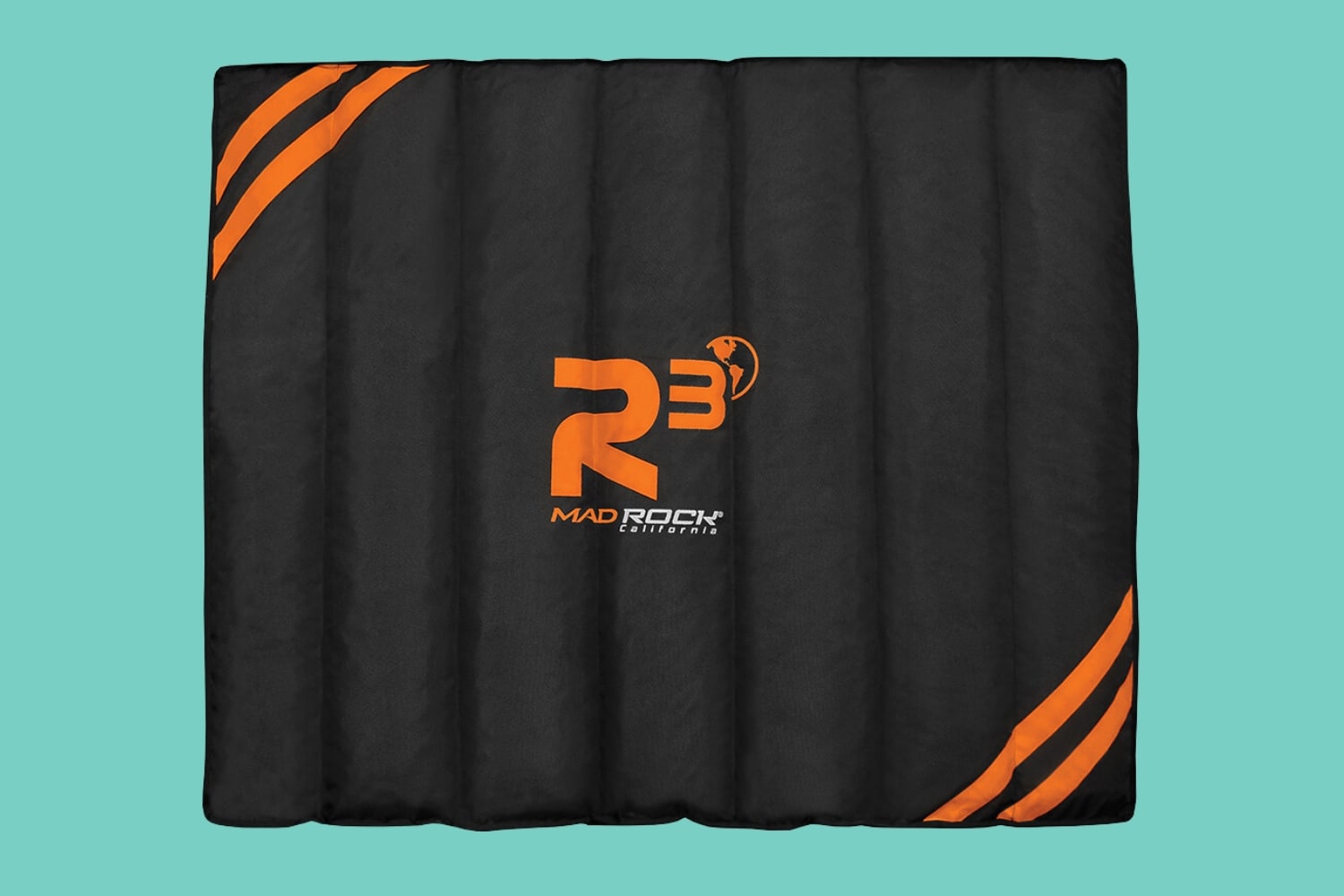
Bottom Line
Its taco-style closure makes packing and transporting gear effortless, and the padded waist and shoulder straps kept us going strong even when the approach took longer.
However, at 18 pounds (8.2 kg), it’s one of the heaviest pads available. Also, while the innovative padding system is great at protecting lower boulders, it leaves something to be desired when used on high-ball problems.
- Easier to protect complicated landings with the baffled taco style design
- Eco-friendly with the use of recycled EVA foam
- Great suspension system with ample support for packing heavy gear
- Great packing space – more than any other pad on the market
- Very sturdy with the 1680 denier nylon construction
- Heavy weight for long approaches
- Shredded EVA foam can accumulates moisture
Introduction
The Mad Rock R3 is a burly, sustainable crash pad for environmental-conscious climbers looking to easily protect sketchy projects with uneven surfaces. Let’s take a look at the highlights and potential drawbacks of the R3 to help you decide if it’s the right pick for your practice.
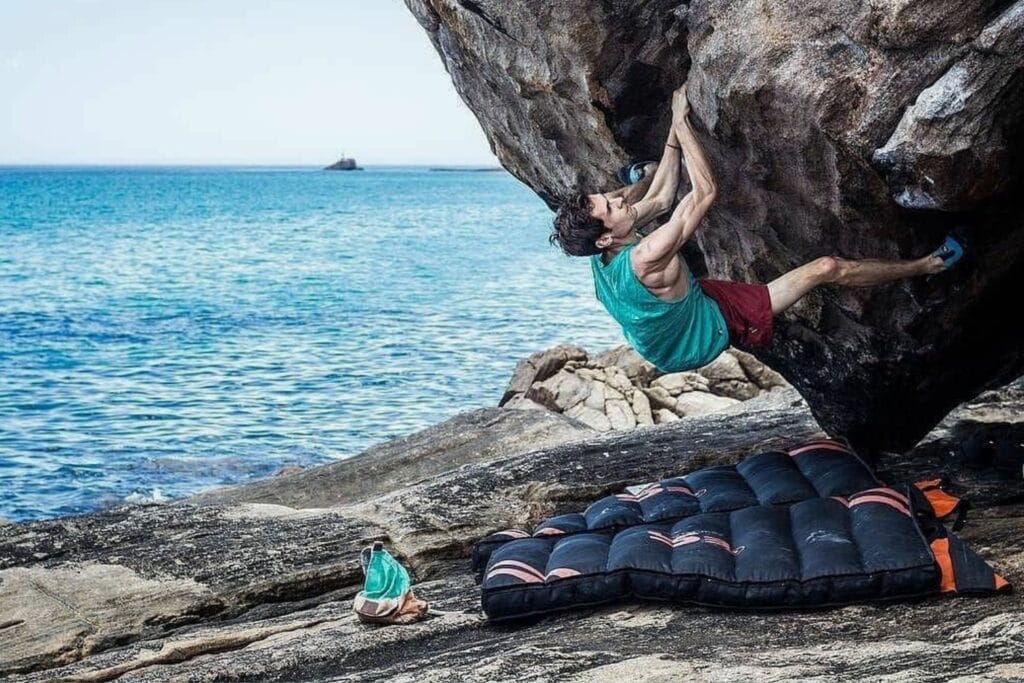
Fall Impact Protection
The R3 pad achieves impact protection using a new and novel system as compared to the traditional crash pad design. The pad comprises tubes (a.k.a. “baffles”) sewn together and filled with shredded, popcorn-sized foam. Apart from being tightly packed with foam, the outer fabric of this crash pad is much thicker than usual and actually plays a part in cushioning a falling climber.
The feel of the R3 is soft compared to most other pads. This is due to the fact that it has no layer of closed cell foam on top. Still, the shredded foam interior provides a good amount of support and doesn’t give way under pressure. For shorter problems, it gives the landing zone an almost plush feel.
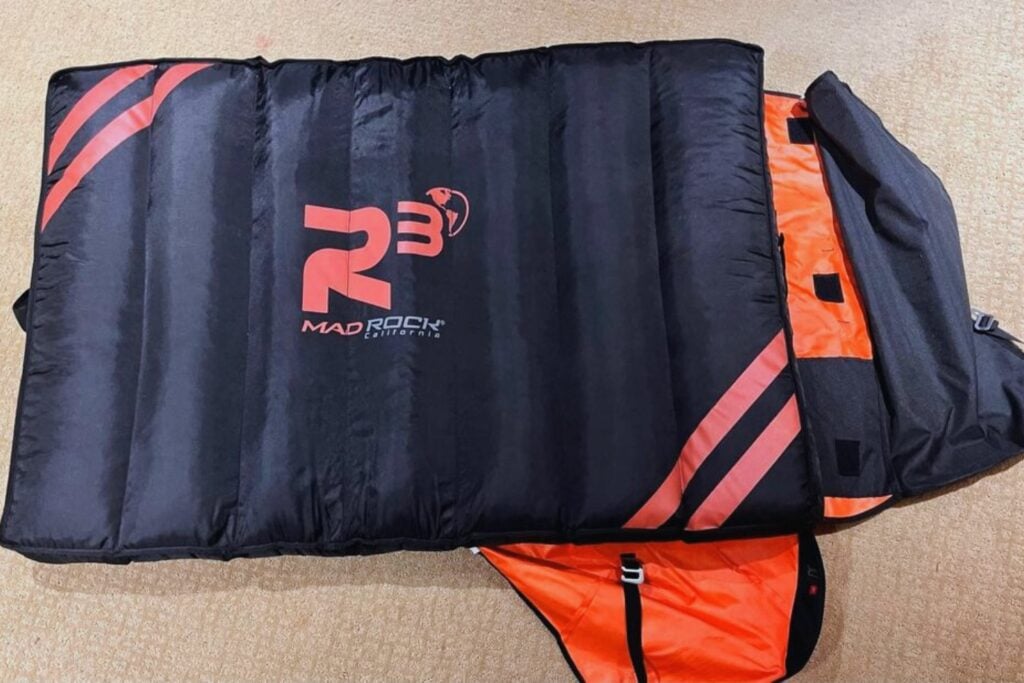
Overall, the baffled design conforms easily to rocky surfaces proving effective to protect tricky landings. However, as a standalone pad on high ball boulders, the Mad Rock R3 pad leaves something to be desired. Compared to pads with a traditional combination of open and closed cell foam, it just doesn’t provide the same amount of protection. In these scenarios, the R3 works better as a satellite/supplemental pad instead of bearing the brunt of the fall as a primary pad.
Durability

When measuring the durability of a crash pad there are two things to consider:
- Fabric exterior
- Foam interior
Fabric exterior
The fabric exterior of the R3 crash pad uses a burly 1680 denier nylon, one of the thickest and most resistant fabrics available today. This is not a pad that you need to worry about ripping. You can drag, flop, scrape, and throw the R3 with confidence. The outer shell is unfazed by sharp rocks and surfaces and will stand up to the elements for many years.
Similarly, the aluminum buckles and daisy chain webbing are heavy duty features that wear well in harsh conditions. When using the pad in pack mode, the attachment points for the straps are all threaded through thick nylon webbing. The latter is solidly attached to the main body of the pad with multiple bar-tacks. This reassured us that even under heavy loads the weight will be well distributed across the pad and won’t end up causing any tears.

Foam interior
As for the inside of the pad, the recycled EVA foam is the part that may have a shorter lifespan. Because it’s shredded, the foam packs out similar to synthetic insulation and loses its loft over time. This means that the foam won’t have the same lifespan as other pad with solid sheets of foam inside.
However, Mad Rock markets the R3 as an eco-conscious pad. As such, it offers replacement foam for when the original stuff packs out so much that it begins to effect performance. This makes the R3 more durable than other pads. Indeed, most competitors don’t service pads once the foam loses shock absorption.
It’s also worth noting that the R3 makes less environmental waste as it uses recycled EVA foam.
Ease of Use

Perhaps the strongest argument for the usability of the Mad Rock R3 pad is its versatility and the ease with which it can protect tricky landings. The baffled design conforms to uneven surfaces better than any other pad we reviewed. It makes landings more secure with the pad less likely to shift under a falling climber.
When unfolded the pad can be maneuvered using one of the two drag handles. Despite the extra poundage, it’s easy enough to shift quickly while spotting. Without a doubt this is the best pad for laying over rocks and other sharp objects that protrude into the landing zone, earning it a place in any good pad system.
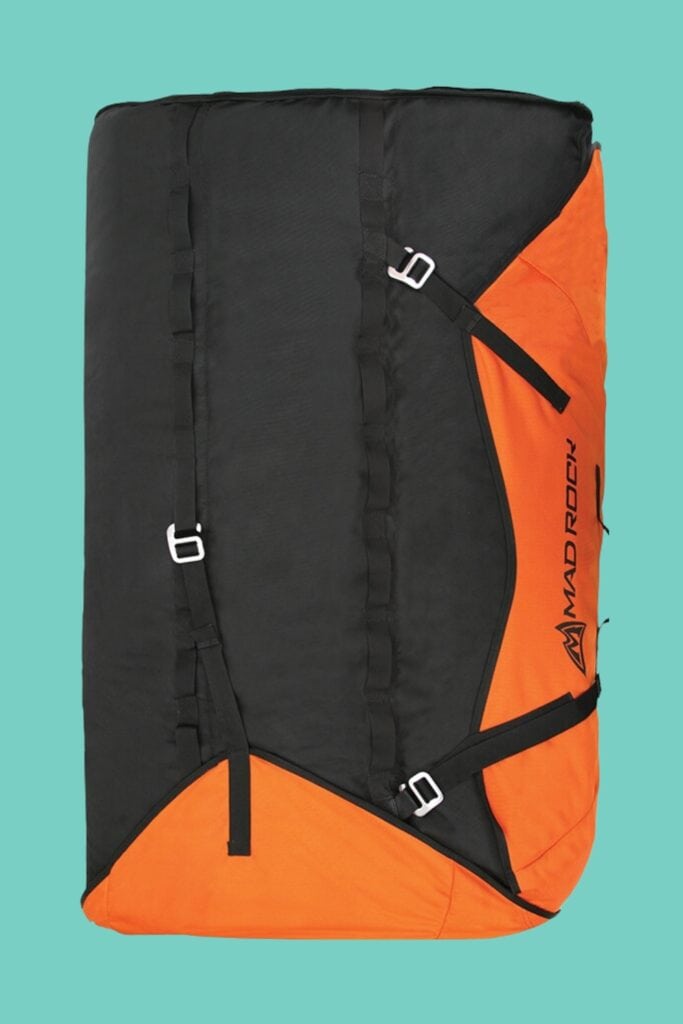
When in use, the closure flaps reverse and the ground shield unfolds to cover the shoulder straps and waist belt to protect them from the dirt. When on your back, you can use the burly daisy chains to cinch down the pad and hang gear for easy access.
Also, the R3 features a velcro flap that can be use to join it securely to other Mad Rock pads for a more secure landing zone.
There aren’t a large variety of pockets or extra features on the R3 pad. It’s comfortable and capable, but not flashy. While other pads have more bells and whistles, the Mad Rock R3 focuses on quality construction and materials.
Last but not least, we noticed that the EVA foam can accumulate moisture. As a result, we had to wipe the pad to dry it. This may not be applicable to dry climates, but you may notice it in more humid weather.
Packing and Transport

Another area where the R3 really shines, packing this pad for transport is fast, easy, and secure. The folded taco provides ample room inside. In fact, the R3 was able to accommodate more gear than any other pad its size.
Large closure straps ensure that even loose items will be safe when stuffed away during transport. Also, the daisy chain system makes it easy to tighten down any size of load.

While many crash pads feature skimpy webbing for the backpack straps, the R3 has full padding on both the waist belt and shoulder straps. Mad Rock clearly considered the weight of the pad plus possible gear packed inside when designing the transport system. Alongside the comfortable shoulder straps is a chest strap which helps keep the pad from pulling backwards when in transit. The suspension system is top notch and compliments the giant packing capacity of the R3 pad perfectly. As such, it provides ample support even when the pad is packed with heavy gear.
However, keep in mind that this pad is no means lightweight (20 lbs/9 kg). We felt a bit of strain after lugging it between different boulders. Let’s just say it’s part of the training!
Conclusion
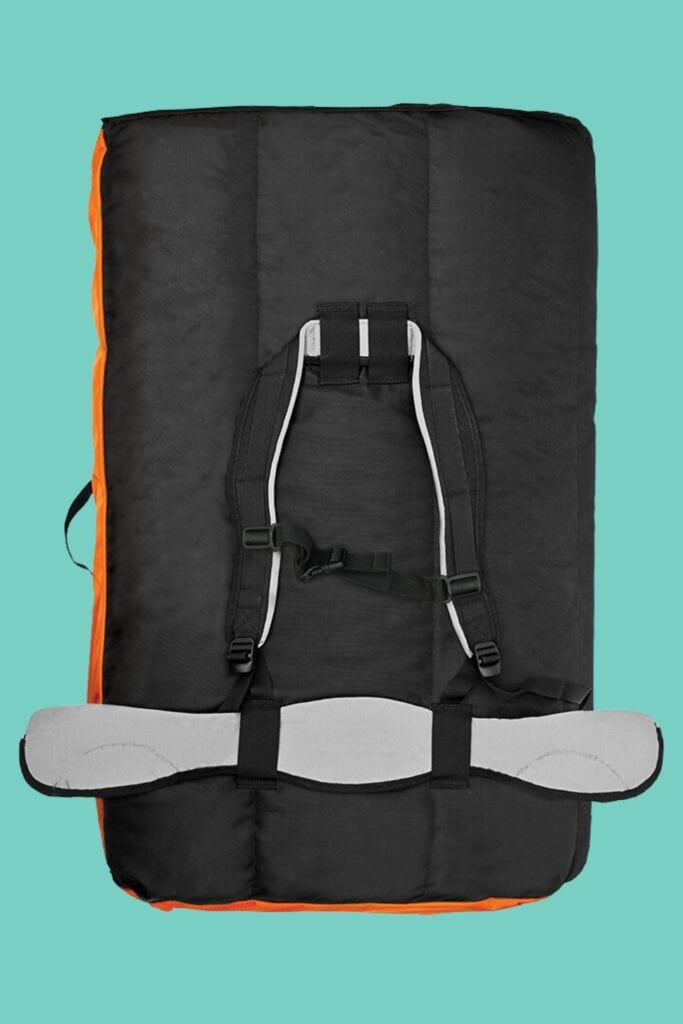
As a pad for low to medium-high boulders, the Mad Rock R3 works great as a primary pad. On larger boulders, its versatility on sketchy landings will be much appreciated.
While heavy, this pad has the benefits of being both environmentally friendly and highly durable. Because the manufacturing costs are reduced by using recycled materials, you get a great value product for a competitive price.
If you’re looking for a primary pad for high-ball boulders, you would be better off with something like the Metolius Magnum for a slightly larger landing area and firmer foam. For general-use bouldering, especially when bringing more gear, the Mad Rock R3 is a great choice.
The ability to easily add extra foam later on, coupled with the already recycled foam filling, means this is the top choice for anyone who wants an environmentally friendly crash pad.
Facts
| Thickness | 4″ (10 cm) |
| Size | 55″ x 35″ (140 x 88 cm) |
| Style | Baffled Taco |
| Weight | 20 lbs (9 kg) |
| Materials used | Recycled open-cell foam, Nylon 1680 denier |
| Closure | Flaps |
Do you need help?
There are dozens of bouldering crash pads on the market. How can you be sure that you’re picking the right one?
Discover our best climbing crash pads selection with a detailed buying guide.
Where to Buy It?
We buy most of our stuff from REI.com. Their service is great, and it’s a co-op, so they treat their employees well and answer to their members, not shareholders.
Backcountry is also a trustworthy retailer with a great selection of climbing products, including crash pads.
Note: we receive a commission when you buy through us. This keeps our team of writers/climbers going!
